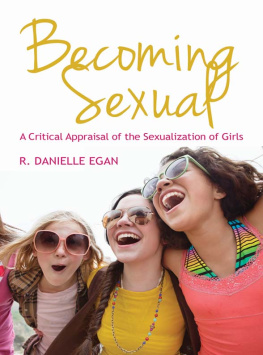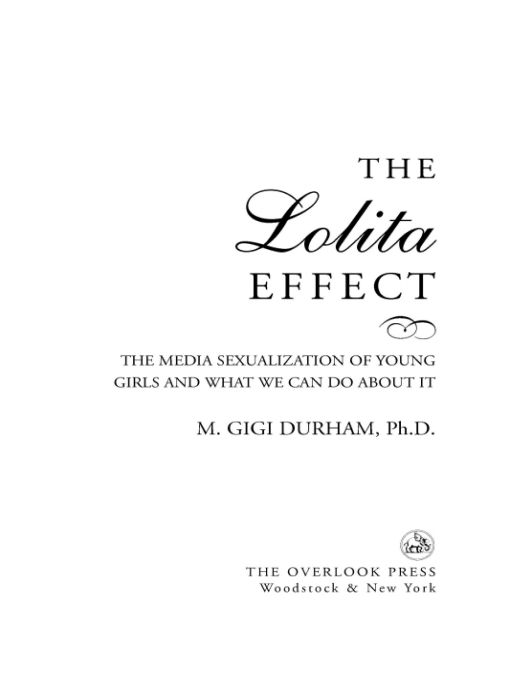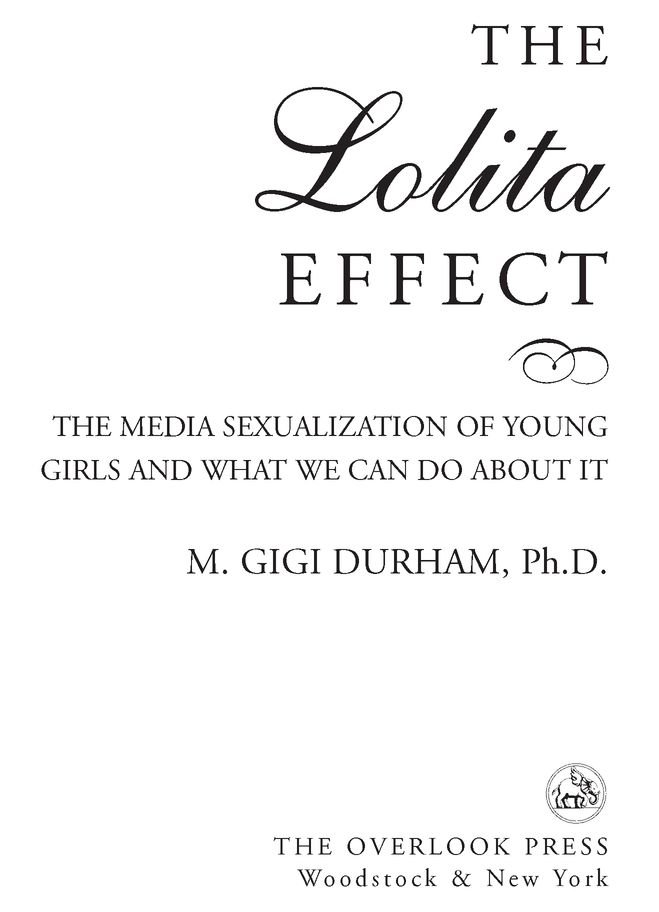Table of Contents
TO MY DAUGHTERS
Sonali and Maya
who have made me think so carefully,
intensely, and lovingly about these issues
Todays children and young men and women have sexual identities that spiral around paper and celluloid phantoms: from Playboy to music videos to the blank torsos in womens magazines, features obscured and eyes extinguished, they are being imprinted with a sexuality that is mass produced, deliberately dehumanizing and inhuman.
NAOMI WOLF, The Beauty Myth
Preface
The Lolita Effect begins with the premise that children are sexual beings. As they mature, they deserve to be furnished with factual, developmentally appropriate, and useful information about sex and sexuality. They need safe environments and lots of room in which to grow and learn about sex in ways that benefit them in the long term. This is especially important for girls, because for so long girls sexuality has been repressed, controlled, and punished in ways that have curbed and subjugated them in this crucial domain.
So the starting point for this book is the fact that sex and sexuality are normal, natural, and, at best, wonderful aspects of being alive, and that the diverse range of expressions of sexual feelings can be both inspiring and valid. At the same time, it is important to recognize childhood as a time of learning and growth, and to acknowledge that caring adults have a responsibility to guide children toward healthy, fulfilled, and capable adult lives.
Right now, the media arent doing much to contribute to this goal as far as sex is concerned; in fact, they are mishandling and distorting girls sexuality. This book homes in on the ways that the mainstream corporate media construct sex and sexuality in ways that actually limit and hamper girls healthy sexual development. This is what I have dubbed The Lolita Effectthe distorted and delusional set of myths about girls sexuality that circulates widely in our culture and throughout the world, that works to limit, undermine, and restrict girls sexual progress. In this book, I aim to give parents, educators, media audiences, and advocates the tools to recognize and respond proactively to these myths so that we can work together in the best interests of the girls who look to us for guidance.
In todays media-saturated environment, children are bombarded with images and messages about sex and sexuality at very early ages. Unfortunately, theres lots of evidence that the messages theyre getting about sex are harmful rather than helpful. Because children are engaging in sexual activity at earlier ages, rates of teen pregnancy are rising in the United States and elsewhere, and the incidence of sexually transmitted diseases among teenagers is extremely high. And child sexual abuse is too commonthe World Health Organization estimates that 25 percent of all girls and 8 percent of boys have been subjected to some form of sexual abuse; in the United States, an estimated 20 percent of boys and 25 percent of girls have been sexually molested.
Because its so clear that we arent doing a good job of ensuring childrens sexual safety and well-being, I hope to open up a discussion about how we can do better to confront the problematic and manipulative ideas about sex that circulate in commercial popular culture.
From that position, this book is not about censoring, ignoring, or repressing discussions about sex. On the contrary, its about galvanizing more open and active dialogues about sexuality, especially girls sexuality. Everyone is sexual, and the range of ways in which sexuality is expressed and experienced is diverse and multifaceted. It is crucial to recognize that sexual feelings, curiosities, and responses begin very early in life, and that our best move is to support and nurture young people as they develop sexually, intellectually, psychologically, and in other ways. In many ways we arent doing a good job of differentiating healthy sexuality from damaging and exploitative sexuality. And we arent always thinking about whats appropriate at different developmental stages: what kids can handle, how best to present sexual information to them, and how to guide them through the complicated and precarious terrain of sex.
In general, we are squeamish about talking directly and rationally about sex, even though we are only too happy to indulge in the prurient, voyeuristic, and titillating versions of sex that proliferate in popular culture and mainstream media. Our puritanical but passive attitude is at the root of our problems. Weve got to tackle this issue head-on. We need to talk about it, to gain some critical distance from the media that surround us, and to find more productive, progressive, and positive ways to think about girls and sexways that are good for them and good for society as a whole. And we need to do this in collaboration with girls, who are bright, thoughtful, and crucial participants in this discussion. They dont need rescuing from sex. Rather, they need our respect and attention as they explore what should be a healthy and natural part of their lives as they become adults.
This really matters, because the media, which are driven by profit and ratings, arent in the business of respecting or advocating for girls. As far as the media industries go, cultivating consumers as early as possible is a central goal. Thats why were seeing increasingly adult content being aimed at very young children; thats why the dolls sold to preschoolers look exactly like the half-dressed women in music videos and soft-core mens magazines, and why toddlers fashions are almost indistinguishable from those of teenagers. Marketers call this KGOY, or Kids Getting Older Younger: thats where the developmental differences among children are blurred by the media through strategies geared toward creating consumer bases as early as possible. But we must remember that children arent in charge of this trend, even though media managers and marketers want us to believe they are. This phenomenon originates from corporate command centers seeking to maximize their reach and profits. And its changing the landscape of childhood.
This is why, in this book, I use the term girls broadly, to span an age range from preschool to the late teens. Even though girls at different developmental ages process and cope with media messages about sex and sexuality differently, the messages themselves are reaching across very diverse age groups: toddlers see R-rated films; preschoolers watch MTV; grade-school children tune in to Victorias Secret fashion shows; everyone gets on the Internet. In Vladimir Nabokovs novel Lolita, he rhapsodizes about nine- to fourteen-year-old girls as inhabiting a special category of nymphets, and in general I am thinking of this age range as I write. But the borders of girlhood have extended beyond these margins. And our concept of a girl is necessarily unclear. Those of us who are in frequent contact with girls know this to be true.
While this book is pro-girl, in a way, its also pro-media. The media are part of our lives, and they enrich and enliven them. In general, the mainstream media are in the business of providing programming that both captivates audiences and attracts advertisers; their goals are mundanely mercenary rather than actively malicious. But the fallout can be quite serious. One dimension of becoming an active and critical media consumer is to talk back to the media, to lead them toward engaging responsibly with their audiences and finding more enlightened ways to make their profits. Another is being a responsible consumer. We have to know how to control our media environment and how to use the media in ways that better our lives, instead of allowing the media free rein over both public and private spaces. This book represents a step in that direction.






![Harry Turtledove - Worlds that werent : [novellas of alternate history]](/uploads/posts/book/79050/thumbs/harry-turtledove-worlds-that-weren-t-novellas.jpg)




